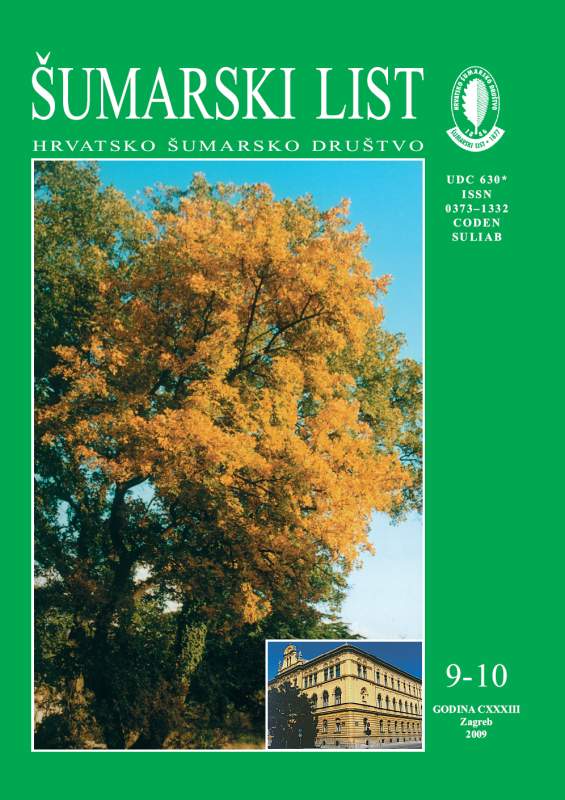
broj: 9-10/2009
pdf (8,1 MB) |
|
||||||||||||||
| RIJEČ GLAVNOGA UREDNIKA | ||
| Branimir Prpić | ||
| ON THE ORGANISATIONAL STRUCTURE OF THE COMPANY “HRVATSKE ŠUME” Ltd pdf HR EN | 468 | |
| IZVORNI ZNANSTVENI ČLANCI | ||
| Seletković,I., N. Potočić,A. Jazbec,T. Ćosić,T. Jakovljević | UDK 630* 232.2 + 232.3 (001) | |
| The Influence of Various Growing Substrates and Slow-release Fertilizers on the Growth and Physiological Parameters of Common Beech (Fagus sylvatica L.) Seedlings in a Nursery and Following Planting in the Field pdf HR EN | 469 | |
| Tanušev,V., J. Ištvanić, M. Moro, J. Butković | UDK 630* 333 + 83 (001) | |
| Yield of Low Quality and Small-Sized Diameter Common Beech (Fagus sylvatica L.) Logs in Rough Dimension Stock Production pdf HR EN | 483 | |
| Šušnjar, M., D. Pičman,T. Pentek, D. Horvat, H. Nevečerel, K. Greger | UDK 630* 383 + 432 (001) | |
| Working Characteristics of Terrain Leveler Machine in Forest Fire Road Construction and Carst Melioration pdf HR EN | 493 | |
| Summary: The paper deals with performance of terrain leveler Vermeer T855 in forest fire road construction and carst melioration. Research was caried out in the Mediterranean region on southern part of Croatia (Dalmatia) exactly on the area of forest office Zadar and forest office Buzet. The research was performed during three weeks of the machine work and the following parameters were recorded on a daily basis: effective time, fuel consumption, number of broken knives, length of the processed route, working depth and type of surface. The data gathered covered 22 working days in total. The basic classification of the working days was made according to the depth of work and type of surface. The first 13 days the working depth was 40 cm and during first 3 days the fire-prevention road route was on the ground of loose stones, and the following 10 days, on hard stone ground. During 9 days of work on the depth of 75 cm, the machine was working 6 days on the ground consisting of loose stones and 3 days on hard rocky ground. The measured data served to calculate on a daily basis the efficiency of the machine expressed in the length of processed route within the time unit as well as the fuel consumption per time unit and the length of the processed route and dependence of number of broken knives on the length of the processed route The largest average productivity of the machine of 4.30 m/min has been achieved at the work in ground 40 cm deep consisting of loose stones. At the same working depth, the productivity appears to be considerably lower on hard rocky ground (2.42 m/min). A lower efficiency is achieved at larger working depth. A general conclusion can be made that the productivity depends on the working depth and the type of ground. The larger working depth and the harder ground, the lower productivity. The same sequence occurs when the consumption of knives is examined with regard to the working conditions. On average, when working on the depth of 40 cm in loose stone ground the smallest number of knives are used up. When working at 75 cm in hard stone, the consumption could be from 15 knives/km. The fuel consumption was researched in regard to the constructed route length and to the effective (productive) working time. There are no more significant differences in fuel consumption within a time unit (from 0.89 L/min to 1.04 L/min) in regard to the working conditions. The average fuel consumption regardless of different working conditions comes to 0.93 L/min. Nevertheless, the differences in fuel consumption according to the length of the constructed road route considerably differ with regard to the working depth and the surface. The consumption of only 0.21 L/m has been registered with the work on the depth of 40 cm in loose stone ground. At the same depth, the consumption is almost double by the route length on the rocky ground (0.41 L/m). As the working depth increases the consumption by route length increases too and the largest consumption was from 0.53 L/m established with the work on the depth of 75 cm in hard stone. Based on the measurement results and introductory study, we can make a conclusion on use of the terrain leveler Vermeer T855 in construction of the forest fire-prevention roads. The advantage of the terrain leveler lies in a possibility of use of the stone material on the forest fire-prevention roads route as well as in new technology of construction of fire-prevention roads where the operation of a machine substitutes several construction machines. | ||
| Ballian, Dalibor | UDK 630* 165 (001) | |
| Genetic Structure of Silver Fir (Abies Alba Mill.) from Western and Eastern Bosnia pdf HR EN | 501 | |
| Bobinac, M., S.Andrašev | UDK 630* 25 (001) | |
| Effects of Silvicultural Measures in Devitalized Middle Aged Oak Stand (Quercus Robur L.) on Chernozem in Vojvodina pdf HR EN | 513 | |
| Farkaš,V., T. Gomerčić, M. Sindičić,V. Slijepčević, Đ. Huber,A. Frković, S. Modrić | UDK 630* 156 (001) | |
| CraniometricalAnalysis and Determination of Sexual Dimorphism in Brown Bear (Ursus arctos L.) from Croatia pdf HR EN | 527 | |


